
Kalimpong
In Gorkhaland, apart from Darjeeling, Kalimpong is also considered to be a major tourist attraction. However, Madhu and I weren’t sure if it was worth a stop – we had kinda gotten tired of the Kanchenjunga views. But then two things happened: we found a homestay-style hotel run by a family that owned dogs and other animals and birds; we had to stay there! Secondly, Kalimpong is located somewhere in between Gangtok and Siliguri, from where we were to take a long train journey to Guwahati – so it felt right to take a break there and chill for a couple of days before the grueling northeast tour!
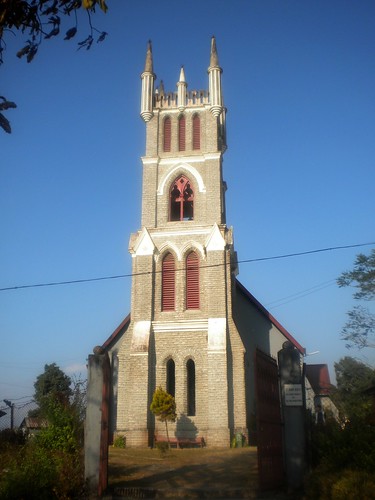 From Gangtok’s jeep stand we were able to get a 9am shared-jeep all the way to Kalimpong. Even though we managed to bag just the last-row seats, it was a relatively comfortable and uneventful ride. Except, of course, for the old man in the middle seat before us: when the jeep stopped for a tea break, he promptly bought himself a quarter bottle of alcohol and a packet of pakoras, both (and all!) of which he nonchalantly enjoyed for the rest of the break – a great source of amusement for the rest of us watching him !!
From Gangtok’s jeep stand we were able to get a 9am shared-jeep all the way to Kalimpong. Even though we managed to bag just the last-row seats, it was a relatively comfortable and uneventful ride. Except, of course, for the old man in the middle seat before us: when the jeep stopped for a tea break, he promptly bought himself a quarter bottle of alcohol and a packet of pakoras, both (and all!) of which he nonchalantly enjoyed for the rest of the break – a great source of amusement for the rest of us watching him !!
Kalimpong, which sits atop a hillock overlooking the Teesta River, is a popular spot for the people of the plains who rush here to cool off from the summer heat. Its town center with a rash of stores and taxis, however, is not very impressive and was hardly what we expected from a tranquil hill-station. But for tranquility all one has to do is head beyond the town into the countryside around – therein lies the true beauty of Kalimpong! It was quite cold when we got there on the morning of Dec 19th but the sun shone strongly over the following days and allowed us to walk around and enjoy the area in leisure!
We spent our first afternoon in Kalimpong walking around its town center and browsing the stores. There wasn’t much to them, though, so we continued on beyond it to a lovely church that sat atop a small hillock. Even though we never really got the name of the church, it turned out to be a well-recognized one as later we found it featured prominently in every old photograph, painting or sketch of the town right from its British days. Even today, in spite of the plethora of buildings that have sprouted within the town center, the church is still quite visible from afar. Since it was a Sunday, church goers were attending mass in its prayer hall with a choir singing soulfully in English. We stood around listening to them from the entrance doors but didn’t dare disturb by entering. So we could only view the church from the outside. It’s located quite beautifully with lovely views of the town spread below it; a great place to spend a few minutes relaxing and enjoying the cool mountain breeze!
The following morning we took a cab to Durpin 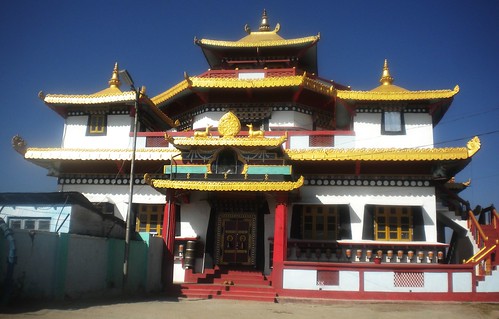 Monastery, which sits atop a hill at the southern end of town. The 3-storey monastery has a lovely facade but this was somewhat marred by an ugly metal enclosure to the left – not sure what it housed! A monk opened the doors of the monastery’s prayer hall for us and a bunch of other visitors. We were able to view the prayer hall on the 2nd floor as well. Here a family including an elderly couple in traditional Ladakhi outfits was paying their respects when we walked in. Two young Ladakhi kids, a boy and a girl, stood before each idol with folded hands and chanted out prayers loudly – it was both cute and extremely amusing to witness !
Monastery, which sits atop a hill at the southern end of town. The 3-storey monastery has a lovely facade but this was somewhat marred by an ugly metal enclosure to the left – not sure what it housed! A monk opened the doors of the monastery’s prayer hall for us and a bunch of other visitors. We were able to view the prayer hall on the 2nd floor as well. Here a family including an elderly couple in traditional Ladakhi outfits was paying their respects when we walked in. Two young Ladakhi kids, a boy and a girl, stood before each idol with folded hands and chanted out prayers loudly – it was both cute and extremely amusing to witness !
On our way down from the monastery (we had decided to walk back!), we stopped at a viewpoint from where views out to Kalimpong city and the Teesta River were supposed to be spectacular. But the fenced-in point was full of trash and we couldn’t bear standing there for more than a second – when will this country and its citizens start doing something this trash problem?!! There’s got to be a solution out there!
Our guesthouse’s owner had suggested that we walk down to West Bengal tourism’s Tourist Lodge, which is housed in an old colonial house called the Morgan House. En route we passed an army base that looked huge and immaculately maintained. A soldier guarding the entrance to a lovely golf course helpfully gave us directions to the lodge.
We didn’t expect much from the Tourist Lodge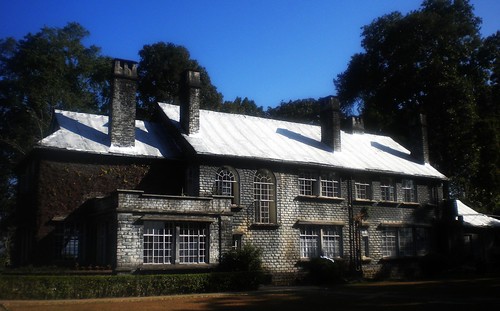 but it turned out to be a lovely Georgian stone house set on grounds that had fabulous views of the surrounding mountains. When we expressed curiosity, the lodge manager kindly showed us to one of the rooms on the ground floor, which had been recently updated – it looked quaint and charming. When we ordered tea and sandwiches, they set out a table and couple of chairs for us in the lawn and here we spent a leisurely hour enjoying the warm morning sun – it was the best part of our day in Kalimpong!
but it turned out to be a lovely Georgian stone house set on grounds that had fabulous views of the surrounding mountains. When we expressed curiosity, the lodge manager kindly showed us to one of the rooms on the ground floor, which had been recently updated – it looked quaint and charming. When we ordered tea and sandwiches, they set out a table and couple of chairs for us in the lawn and here we spent a leisurely hour enjoying the warm morning sun – it was the best part of our day in Kalimpong!
Further down the hill towards Kalimpong town center we saw several colonial homes that have been converted into govt offices or residences. They all looked lovely, ensconced in beautiful gardens and with perfect views; we were quite envious! Along the way we stopped at a small store where women were busy weaving and knitting wool to make some lovely stoles, sweaters, caps and gloves. They didn’t have much in stock to sell and seemed to be extremely busy trying to fill an order. However, we managed to buy a lovely, hand-woven stole for a very reasonable price of Rs.250.
The following morning we took another cab to Dr. Graham’s House, which is an orphanage and school built by a Scottish missionary back in 1900.  It sits atop a hill to the northeast of town and has a fabulous location. The school was closed for the holidays and was set to reopen only by Feb but we were able to tour its lovely grounds and envy the children for their piece of paradise. The school and hostel buildings, which are all painted in camouflage colors, surround a large playground in the center and look almost like an army base; looked like a great place to live and study! However, what impressed us most was a lovely church behind the school complex. It sits at a higher elevation and is accessed via a tarred road that leads up to it. Built in 1925 and of grey slate stone with a lovely, pointed spire on the left, the English church almost looks completely out of place in those West Bengal hills. To our disappointment, we found the church doors closed with no one around to help us. So all we could do was walk around the church grounds and appreciate its exteriors, which included a fabulous blue door with silver ornamentation – loved it!
It sits atop a hill to the northeast of town and has a fabulous location. The school was closed for the holidays and was set to reopen only by Feb but we were able to tour its lovely grounds and envy the children for their piece of paradise. The school and hostel buildings, which are all painted in camouflage colors, surround a large playground in the center and look almost like an army base; looked like a great place to live and study! However, what impressed us most was a lovely church behind the school complex. It sits at a higher elevation and is accessed via a tarred road that leads up to it. Built in 1925 and of grey slate stone with a lovely, pointed spire on the left, the English church almost looks completely out of place in those West Bengal hills. To our disappointment, we found the church doors closed with no one around to help us. So all we could do was walk around the church grounds and appreciate its exteriors, which included a fabulous blue door with silver ornamentation – loved it!
Just like the previous day, we decided to walk back down to Kalimpong’s town center, some 3 to 4kms away. About half way there, we stopped at the beautiful Tharpa Choeling Monastery. As 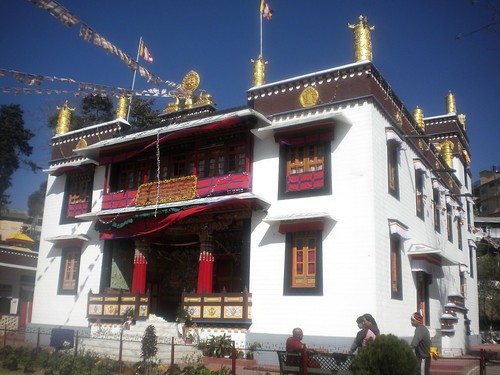 we stepped into its courtyard, we found a few locals sitting near its entrance playing with a gorgeous German Shepherd, which was busy trying to chase and pounce on the shadows created by the people’s fingers. It was absolutely amusing to watch ! We were told that the monastery doors were closed for lunch and would open a few minutes later. So we parked ourselves in the grassy lawn before the monastery and spent our time speaking to a young local who told us that the dog’s name was Bozo and that it had been raised by the monastery’s head monk. When we offered biscuits Bozo came over to us and hung around playfully. The young local informed us that when the Dalai Lama had visited Kalimpong a few days prior, he had stayed in a room within this monastery; we were intrigued!
we stepped into its courtyard, we found a few locals sitting near its entrance playing with a gorgeous German Shepherd, which was busy trying to chase and pounce on the shadows created by the people’s fingers. It was absolutely amusing to watch ! We were told that the monastery doors were closed for lunch and would open a few minutes later. So we parked ourselves in the grassy lawn before the monastery and spent our time speaking to a young local who told us that the dog’s name was Bozo and that it had been raised by the monastery’s head monk. When we offered biscuits Bozo came over to us and hung around playfully. The young local informed us that when the Dalai Lama had visited Kalimpong a few days prior, he had stayed in a room within this monastery; we were intrigued!
About 15 minutes later a monk opened the doors of the monastery for us and we were able to view its fabulous interiors. It had lovely idols of the past (Bhaisajya), present (Sakyamuni) and future (Maitreya) Buddhas. As we stood around admiring the freshly painted murals on the walls, an elderly couple walked  in and proceeded to pray and prostrate before the idols. The young local who had followed us into the monastery whispered that they were the grandparents of an 8yr old boy whom the Dalai Lama had selected as the next Rinpoche of the sect that the monastery belonged to – we were completely overawed! Later just as we were exiting the prayer hall, we noticed that the elderly couple and a younger couple were being escorted by the monk to the upper floor of the monastery. We assumed that it was a private affair but the elderly lady beckoned us to follow them and we happily did. It turned out that they were being given an exclusive peek at the room and prayer hall upstairs where the Dalai Lama stayed! They offered their respects while we stared in awe at the modest interiors, which had images of the Buddha, prayer flags and gorgeous Thangkas. There was definitely a somber, spiritual feel in the air; we felt supremely lucky to have had the opportunity to visit that space! This was one of our best monastery visits ever!
in and proceeded to pray and prostrate before the idols. The young local who had followed us into the monastery whispered that they were the grandparents of an 8yr old boy whom the Dalai Lama had selected as the next Rinpoche of the sect that the monastery belonged to – we were completely overawed! Later just as we were exiting the prayer hall, we noticed that the elderly couple and a younger couple were being escorted by the monk to the upper floor of the monastery. We assumed that it was a private affair but the elderly lady beckoned us to follow them and we happily did. It turned out that they were being given an exclusive peek at the room and prayer hall upstairs where the Dalai Lama stayed! They offered their respects while we stared in awe at the modest interiors, which had images of the Buddha, prayer flags and gorgeous Thangkas. There was definitely a somber, spiritual feel in the air; we felt supremely lucky to have had the opportunity to visit that space! This was one of our best monastery visits ever!
We spent the afternoon browsing through various shops buying gifts for family and souvenirs for ourselves. Kalimpong has a thriving silk-cloth (dress materials, embroidered Oriental jackets and cushion-covers) market which sells stuff sourced from China. So it’s comparatively cheaper than elsewhere in the country. We ended up purchasing a couple of pretty silk cushion-covers for just about Rs.150 each!
After lunch we took a cab to Pineview Nursery, 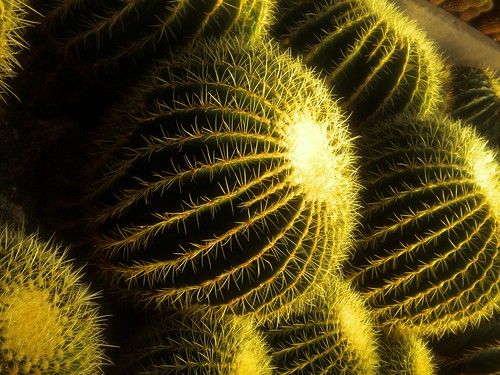 which was listed in the guidebooks as a lovely cactus nursery that was definitely worth a visit. However, it didn’t turn out to be all that great. They charged us Rs.10 per person for entry and then opened only a couple of the 4 greenhouse sheds that lined the property to the left of the entrance. Of course, the cacti displayed in them was quite beautiful and of a wonderful variety. But the nursery wasn’t as big as we had imagined it to be; we even heard a couple of other visitors grumbling about having to shell out money for something this small. The nursery owners run a hotel as well in the same premises and that’s probably their main focus.
which was listed in the guidebooks as a lovely cactus nursery that was definitely worth a visit. However, it didn’t turn out to be all that great. They charged us Rs.10 per person for entry and then opened only a couple of the 4 greenhouse sheds that lined the property to the left of the entrance. Of course, the cacti displayed in them was quite beautiful and of a wonderful variety. But the nursery wasn’t as big as we had imagined it to be; we even heard a couple of other visitors grumbling about having to shell out money for something this small. The nursery owners run a hotel as well in the same premises and that’s probably their main focus.
From the nursery, since there was still an hour or so left before sunset, we walked to St. Teresa’s church, which is just about a couple of kilometers further south of the nursery. However, it wasn’t very easy to find. The church is hidden atop a hillock behind the St. Francis’ school and church. We had to several people and take directions from kids playing in the school yard before finding the church. Its exterior facade wasn’t very impressive as it seemed to be built of tin shed. But the interior prayer hall was simple and gorgeous in dark wood. While we peeked around, a band of young musicians sat in the loft above practicing for choir; it gave the place a wonderful feel! It’s said that when missionaries first built the church they built it to look like a monastery and made the idols and paintings of Christian saints have features similar to the locals just so that they were better or more easily accepted – an interesting strategy!
Our original plan was to continue east towards Guwahati after Kalimpong. But the festive season, which was just round the corner, suddenly made us crave for some family time. We remembered feeling lonely in Mysore during Diwali and didn’t want to feel the same during Christmas as well. So instead of booking train tickets to Guwahati, we booked air tickets for Delhi for the following morning !
As we boarded our Delhi flight, I couldn’t help but look back at the year gone by. 2010 has been unbelievably unique and overwhelmingly wonderful; a year we will never forget for the rest of our lives! Will 2011 beat it?! Only time will tell. I have my doubts, though !


No comments yet.